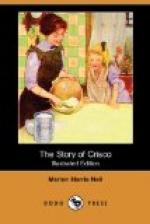Pork, like all white meat, is quick to taint, and never should be kept long before cooking. If you have the slightest doubt about pork, it is best to reject it, for unlike other meat which may be quite wholesome and usable, though not of precisely prime quality, pork must be in really first class condition to be wholesome, and therefore it is impossible to be too particular in the choice of it. Always if possible look at the tongue, for, as in beef, this is a very fair criterion of the condition of the animal; a freshly scraped new wooden skewer run into the meat along the bone is a good test of the freshness of the pork, and be careful especially to examine the fat, for if there be little kernels in it the pork is “measly,” a very common disease among pigs, and one particularly unwholesome to the consumer.
Pigs for fresh pork should be of medium size, not over fat, and under a year old. Pigs destined to become bacon are usually older and larger. Sucking pigs should be small, and are best when about three weeks old. A sucking pig should be cooked as soon as possible after it is killed, as it taints very quickly; unless fresh, no care in the cooking will make the crackling crisp, as it should be.
Ham—Bacon
Good bacon has the lean of a bright pink and fine in the grain, while the fat is white and firm. If the lean is high colored, it probably has been over salted and is old besides, and in consequence will be hard and salty; while if there be yellow marks in the fat, and a curious, rather musty smell, it will have an unpleasant taste. In choosing a ham always run a clean knife or skewer in at the knuckle, and also at the center; if it comes out clean and smelling sweet, the ham is good; but if out of order the blade of the knife will be smeared and greasy looking, and have a disagreeable, strong odor.
Venison
The condition of venison is judged chiefly by the fat, which should be a clear creamy white color, and close in texture. Always try venison by running a sharp knife along the haunch bone, which is usually the first to turn; if, in taking it out, the knife has a blackish-green look and an unpleasant odor, the meat is tainted, and unfit for use. Venison requires to be kept a considerable time before it is in proper condition, and needs great care in its management. It must be examined carefully every day, and if there is the slightest doubt, it should be washed in lukewarm milk and water, then dried in clean cloths, and when perfectly dry, should be covered thickly all over with ground ginger and pepper; when required for use, dust off the pepper and ginger, and wash the meat in a little lukewarm water, and dry it thoroughly. Venison, like mutton, improves with age, and this can be judged by the condition of the hoof, which in a young animal has a small, smooth cleft, while in an old one it is deeply cut and rugged. The haunch is the prime joint, its perfection depending on the greater or less depth of the fat on it. The neck and shoulder also are very good. They are used chiefly for stews or pies.




